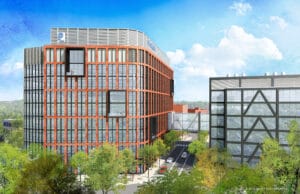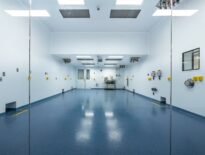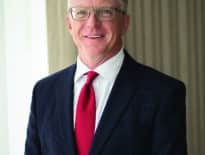
Mark Development received approval this month to build life science space at its long-planned Riverside mixed-use development in Newton, in a shift from previous plans for traditional office space. Image courtesy of Elkus Manfredi Architects
The Newton City Council approved zoning changes this month that allow Mark Development to add a major life science component to its massive mixed-use project destined to transform the area near the MBTA’s Riverside Green Line station.
The move follows Alexandria Real Estate Equities’ recent 63,000-square-foot lease deal with Corindus, a subsidiary of Siemens, at its nearby Riverside Center office park in Auburndale.
Both projects raise the question: Is Newton set to emerge as the region’s next life science cluster, as pharmaceutical and biotech companies increasingly look outside of Cambridge’s crowded and expensive Kendall Square for desperately needed space?
Commercial real estate sources say Newton has the potential to do so, considering its convenient access to major highways and mass transit and its urban amenities that so many workers and employers value these days.
“Newton has a lot of the checkboxes that companies want,” says Mark Bruso, senior research manager at JLL. “It’s poised to grow.”
But Bruso and others raise some caveats when it comes to declaring Newton as the next major life science cluster in the Boston area. Chief among them: The lack of available and affordable land in Newton, and competition from other nearby cities, such as Watertown and Waltham, with more mature communities of companies.
“Newton is playing catch-up,” said Tucker White, director of research at Hunneman, the Boston-based commercial real estate firm.
The city currently has less than 100,000 square feet of existing life-science space, White noted, with tentative plans to add as much as 600,000 additional square feet of space if various projects, including Mark Development’s Riverside proposal, move forward.
Maturing Cluster in the Watch City
In contrast, neighboring Watertown already has 1.6 million square feet of existing life-science space – with an additional 2.3 million square feet in the planning stages, according to Hunneman data. Meanwhile, Waltham has 2.8 million square feet of lab space – with an additional 2.5 million square feet in the planning stages. Other submarkets, including Boston’s Fenway neighborhood and Somerville, have potential major new clusters in the permitting and construction pipeline.
With its urban amenities and MBTA Green Line and commuter rail connections, Newton possesses some key advantages, White said.
But life science workers value more than just train stations and hip restaurants, bars and coffee shops. They also want to be able to network with workers at other industry companies – and Newton is a long way from having that key cluster characteristic, White noted.
Alejandro Miranda, director of project development at Boylston Properties, agrees that a true cluster must include a number of nearby life science companies, so workers can regularly intermingle with each other.
“It’s a big recruiting and retention tool,” he said.

Newton office parks are in demand by life science developers including Alexandria Real Estate Equities, which acquired Riverside Center at 275 Grove St. in 2020 and leased 63,000 square feet to vascular robot specialist Corindus. Photo by Bruce T. Martin Photography | Courtesy Photo
Missing Ingredient Could Be Coming
Miranda is familiar with burgeoning life science clusters: his firm has been very active in Watertown of late, recently developing and then selling off the LINX building at 490 Arsenal Way for nearly $158 million and today developing a combined 285,000 square feet of space at 100 Forge and 500 Forge at Arsenal Yards.
Miranda says Boylston Properties would be eager to develop life science space in Newton and other communities – if affordable land is available and if sites have the promise to expand into viable clusters along with other life science companies.
Robert Korff, chief executive of Mark Development, said creating an industry hub is exactly what his firm, Alexandria Real Estate Equities and others are doing in Newton.
“We’re already building a cluster,” he said, adding that the Riverside site has “all the bells and whistles” that companies say they want and need.
The revised Riverside plan approved by the Newton City Council this month includes 362,000 square feet of space that can be used for office, life science and lab purposes, 22,000 square feet of ground-floor commercial space, 2,172 parking spaces, more than 500 housing units and a plan to repurpose another building into lab and research space, according to published reports.
Korff said he’s had “casual conversations” about possibly developing other sites in Newton.
“So far, I haven’t gotten much traction,” he said.
Opportunity Knocks on Wells Avenue
Brokerage 128 CRE hopes there’s traction for a Newton site it’s now pitching as a potential “medical, lab, flex” redevelopment opportunity at 135 Wells Ave., a vacant 60,700-square-foot recreational facility previously occupied by Boston Sports Club.
Jeremy A. Freid, a senior partner at 128 CRE, said a number of life science and traditional developers have expressed interest in the property.
“It’s been crazy,” he said. “We’ve received hundreds of inquiries.”
But he said it’s not clear if the property will end up as a life science center, considering the volume of lab projects under way or planned in the Boston area.
“It all comes down to timing and how much [life science] space can be absorbed,” he said.
JLL’s Bruso said there’s robust demand for more life science space in Greater Boston – about 8 million square feet of unmet demand to be exact.
“All things being equal, most firms would prefer to be around Kendall Square,” he said. “But they can’t find space there, so they’re looking elsewhere. Newton isn’t going to blossom [into a cluster] right away, but it definitely has the potential.”




 |
| 

